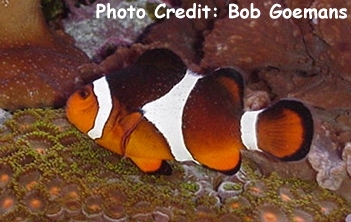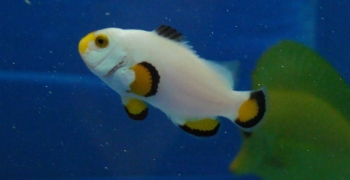
By Bob Goemans

Likely Reef Tank Suitable
Likely Fish-Only Tank Suitable
Range: Indo-West Pacific Ocean: Papua New Guinea and Solomon Islands, south to the Great Barrier Reef.
Size: 3 inches (8 cm)
Natural Environment: Inhabits protected lagoons, outer reef crests and reef faces at depths between 3 to about 40 feet (1 – 12 m) and usually found in small groups inhabiting various anemones where it feeds on planktonic crustaceans (copepods, mysis, and shrimp larvae), and algae.
General Husbandry: Quite common in the trade, and very hardy, peaceful and an excellent tankmate for most peaceful aquariums. Has a orange body with three white bands edged in black, one one the head, one mid body and the third at the base of the tail. Other varients exist, having more black in body with three white similarly located bands.
Best maintained in aquaria having live rock, hiding places, macroalgae, peaceful tankmates, and with or without a hosting anemone. And should a hosting anemone be offered, this species becomes somewhat aggressive to species in other families, as it is protecting its home.
As to diet, will eat most regular aquarium foods, e.g., live fortified brine shrimp and/or finely chopped various frozen or fresh meaty foods such as mysis, squid, fish flesh, shrimp, clam, etc., and plant material, e.g., flake foods, especially those containing Spirulina and should be offered once or twice daily.
Taxonomy:
Order: Perciformes
Suborder: Labroidei
Family: Pomacentridae
Subfamily: Amphiprioninae
Genus: Amphiprion
FYI: In the wild, its hosting anemones are: Heteractis crispa, Heteractis magnifica, and Stichodactyla gigantea.
If maintained with a hosting anemone, aquarium size should be >50 gallons.
Somewhat aggressive with other members of the genus.
They are poor swimmers and may not venture far in the aquarium once they find a place of their liking.
Best housed as a single specimen or as a mated pair.
Placing two juveniles into the same aquarium will, in about 60 days, result in a male-female pair.
If no anemone, may pester large-polyped stony corals, irritating the coral.
Females are larger than males.
If the female is removed, the male will change sex and one of the juveniles that inhabit the anemone will become the new functioning male.
This species is susceptible to Brooklyella hostilis and Amyloodinium ocellatum.
A member of the Percula Complex.
Captive bred specimens available and are far hardier than wild caught specimens.
New color variations through interspecies breeding of this species continue to enter the hobby, making for some striking color variants.
Experience Level: Beginner
Temperament: Peaceful
Diet: Omnivore
Coral Safe: Yes
Invertebrate Safe: With caution
Acclimation Time: 30 minutes+
Aquarium Environment: Reef or fish-only aquarium
Tankmates: Peaceful
Minimum Tank Size: 30 gallons
Temperature Range: 74 - 82°F (23 – 27°C)
Specific Gravity: 1.020 - 1.026
pH: 8.0 - 8.5

